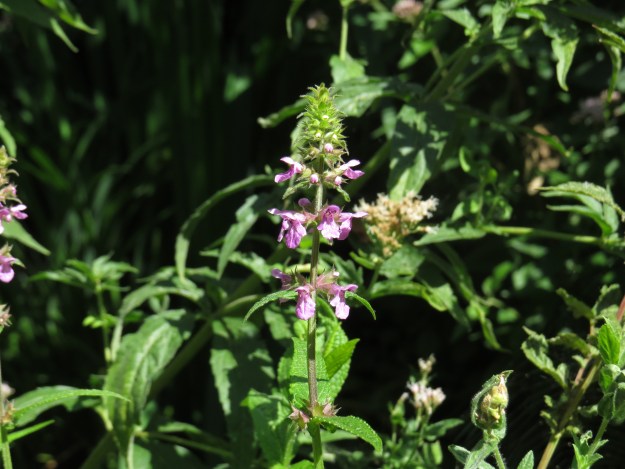
Marsh woundwort (Stachy palustris)
Dear Readers, it is always such a delight when a new plant pops up alongside the pond. I have been watching this one for some weeks, so when it came into flower I was, for a moment, a little confused. Clearly it’s a deadnettle, but I thought it might be hedge woundwort (Stachys sylvatica). The pale pink flowers are a giveaway though, plus the leaves on the upper stem are stalkless. In addition, the leaves of hedge woundwort give off a rather unpleasant smell when crushed, whereas those of marsh woundwort are much less scented. Finally, as the name suggests, marsh woundwort likes damp places, and so here it is, nestled amongst the meadowsweet and the hemp agrimony.

Marsh woundwort is native to the UK and to most of Europe and Asia, and has been introduced to North America. Like all of the woundworts, it has a long history of use medicinally – in her ‘Modern Herbal‘, Mrs Grieve tells the following story:
This plant had formerly a great reputation as a vulnerary, being strongly recommended by Gerard in his Herbal. He tells us that once being in Kent, visiting a patient, he accidentally heard of a countryman who had cut himself severely with a scythe, and had bound a quantity of this herb, bruised with grease and ‘laid upon in manner of a poultice’ over the wound, which healed in a week, though it would ‘have required forty daies with balsam itself.’ Gerard continues:’I saw the wound and offered to heal the same for charietie, which he refused, saying I could not heal it so well as himself – a clownish answer, I confesse, without any thanks for my good-will: whereupon I have named it “Clown’s Woundwort.” ‘
Afterwards, however, Gerard himself used the plant to cure many ‘grievous wounds’, including some that were considered life-threatening. Mrs Grieve says that the plant, when harvested in July, just as it comes into flower, can be used to relieve gout, cramps, pains in the joints and vertigo. The fresh juice can be made into a syrup and used to alleviate haemorrhage and dysentery. In a more recent record, Monica Wilde, a forager and herbalist, records how marsh woundwort tea, and a poultice soaked in the liquid, helped to alleviate the symptoms from a very nasty insect bite. Very interesting stuff.

Marsh woundwort is also said to be edible – the roots, according to Mrs Grieve ‘are tuberous and can attain a considerable size’. When boiled, they are said to form ‘a wholesome and nutritious food, rather agreeable in flavour’. The roots were also dried, powdered, and added to bread and soup in the winter months when there was not much in the way of greens to eat. The shoots can also be eaten and are said to taste pleasant in spite of their disagreeable smell.
In Shetland, marsh woundwort, along with several other plants, was known as grice mooriks, with ‘grice’ meaning ‘pig’ and ‘moorik’ meaning ‘edible root’. So clearly it wasn’t just humans who found the roots palatable.

Marsh Woundwort roots from https://1left.wordpress.com/2016/05/15/marsh-woundwort/
Like all deadnettle species, the flowers of marsh woundwort are popular with bumblebees. The caterpillars of the rather spectacular speckled yellow moth (Pseudopanthera macularia) can also be found feeding on woundworts of all kinds, and what a fine moth it is!

Speckled Yellow moth (Pseudopanthera macularia) (Photo One)
And finally, a poem. This is so atmospheric – set during the English Civil War, you can almost hear the hammering as the church is stripped of its angels and decoration, smell the smoke. See what you think.
Commission by Damian Walford Davies
Photo Credits
Photo One by Ben Sale from UK, CC BY 2.0 <https://creativecommons.org/licenses/by/2.0>, via Wikimedia Commons
This is a fascinating piece.
Imagine that! In your garden, by your pond! I hope the beautiful speckled yellow moth comes by. I’m looking forward to seeing a photo of it when it does. And the poem, more evocative still after just finishing CJ Sansom’s Dissolution.
Ooh, would you recommend the Sansom Virginia?
I’ve only read that one so far and liked it a lot. I couldn’t imagine how he knew all the details. I also loved Winter In Madrid.
The ending: he loads his musket (?) with three
balls, aims at the carved wooden, gilded angels in the roof and leaves, covered with their gold dust. Very matter of fact and callous, the Sergeant included.
Is that correct?
The poem for me calls to mind Southwold Church, and other Suffolk churches with gargoyles and broken statues.
That’s how I interpreted it, Ann, though I’m a bit puzzled about the ‘tan bird’ that the sergeant is holding – mewing is usually how a bird of prey’s call is described. A very enigmatic poem, and quite atmospheric I thought….
Thank you, this is one of your best articles, so complete, from botanic to poetry …I will try to spot one of these during my walks.
Oh thank you Claire, let me know if you spot some – it’s not very obtrusive so it’s easy to miss!
We have these in profusion in our woods. Some sick poem that one!
How interesting, Mal! I’m guessing your woods are a lot damper than ours are at the moment….
If it can relieve vertigo, does it have the same properties as Wood Betony (Stachys Officinalis) to relieve headaches and is a mild nervine?
I’m not a herbalist so I wouldn’t like to vouch for it – however, it’s always worth having a look at Mrs Grieve’s herbal. Here’s her entry on Marsh Woundwort – https://www.botanical.com/botanical/mgmh/w/woumar39.html